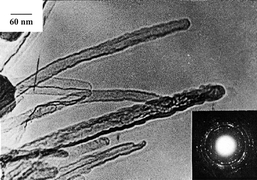Inorganic nanotubes†
Abstract
Carbon nanotubes were discovered in 1991. It was soon recognized that layered metal dichalcogenides such as MoS2 could also form fullerene and nanotube type structures, and the first synthesis was reported in 1992. Since then, a large number of layered chalcogenides and other materials have been shown to form nanotubes and their structures investigated by electron microscopy. Inorganic nanotubes constitute an important family of nanostructures with interesting properties and potential applications. In this article, we discuss the progress made in this novel class of inorganic nanomaterials.


 Please wait while we load your content...
Please wait while we load your content...